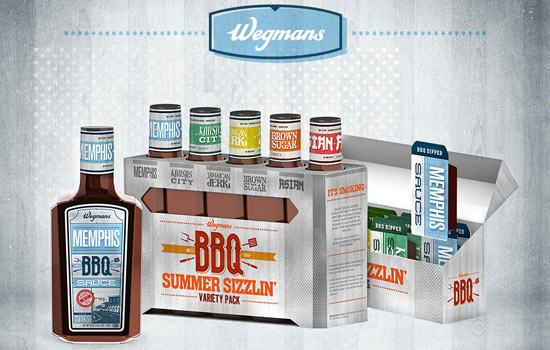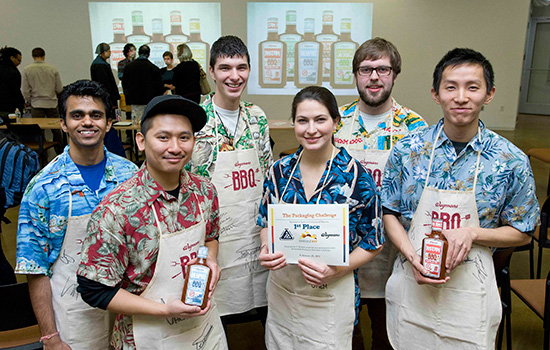Students Re-Package ‘Foods You Feel Good About’
Design for Wegmans BBQ Sauce wins packaging competition
The team of Sumeet Deshpante, Tuan Tran, Marco Fesyuk, Christin Allesio, Simon Jones and Chen Guo Wei was the grand-prize winner at the recent American Packaging-Wegmans Design Competition, redesigning packaging for Wegmans barbecue sauce.
The Hawaiian shirts were as sleek and eye-catching as the new barbecue sauce bottle designs.
Students Simon Jones, Tuan Tran, Marco Fesyuk, Chen Guo Wei, Sumeet Deshpante and Christin Allessio made a lighthearted presentation dressed in “aloha-wear.” But they took a serious approach to revamp Wegmans’ hearty barbecue sauce packaging in the recent American Packaging Corp./Wegmans Student Design Challenge.
The effort earned the team first place overall in the event on Feb. 22 and 29 at Rochester Institute of Technology’s Center for Student Innovation.
“We decided to go all-out with screen-printed aprons and an elegant display box, which helped get the judges on our side,” says Jones, a fourth-year graphic design student from Fairport, N.Y. “Overall we are extraordinarily thrilled, and although all the projects were extremely well-crafted, we are quite happy to be named winner.”
Students from the packaging science department in RIT’s College of Applied Science and Technology partnered with students from the industrial design and graphic design departments in the university’s College of Imaging Arts and Sciences for the challenge.
Over the winter quarter, eight teams re-worked packaging designs for four Wegmans products: barbecue sauce, laundry detergent, artisan crackers and organic juice. All projects had to include strategies about changes in packaging structure, the materials used and improvements to graphic and ergonomic elements. They were also required to provide evidence of sustainable use and cost savings.
“It’s been an exciting, fun quarter. The student designs were very refreshing, contemporary and very clever,” says Alex Lobos, assistant professor of industrial design. “They came up with some elegant solutions.”
For the winning design, the students swapped a stout-shaped glass bottle for a lightweight, taller plastic bottle, made of polyethylene terephthalate (often referred to as PET, and used in making food and beverage containers). This reduced the individual bottle weight by 84 percent, Jones explains. On individual shipping pallets, weight would be reduced by179 pounds, and 43 percent more of the product could be shipped on one truck. Seven less trucks would be needed for every million bottles shipped, reducing shipping costs and carbon emissions.
“We also recommend a Summer Sizzlin’ Variety Pack in a paperboard container of all the barbecue flavors or BBQ Dippers for sauciness on the go,” Jones added with a laugh.
Collaborative projects between colleges are challenging and require a great deal of planning and flexibility, says Lorrie Frear, associate professor of graphic design.
“But watching the students work together resolving a problem using their various skill sets is an extremely rewarding experience as a teacher and designer.”
The RIT packaging science program looks to industry sponsors to support its undergraduate and graduate course projects, says Karen Proctor, professor of packaging science. Three years ago, the College of Imaging Arts and Science and the College of Applied Science and Technology began collaborating on these industry-sponsored projects. Past sponsors have included Kraft, Colgate-Palmolive and American Packaging Corp.
This was the first year that regional supermarket Wegmans Food Markets participated. Steven Rickey, technical director for American Packaging Corp., and Jason Wadsworth, sustainability coordinator for Wegmans, were judges. The winning team received a monetary award.
“The collaborative team gives the students real-life experience in working successfully with various skill sets necessary to address the project needs,” Proctor adds. “The end result of this teamwork is truly a remarkable effort that delights our sponsors. Our success has been so highly touted that we are lucky to have a long line of companies wanting to sponsor the next course project.”
 The winning design for the American Packaging Corp./Wegmans Student Design Competition.
The winning design for the American Packaging Corp./Wegmans Student Design Competition.














